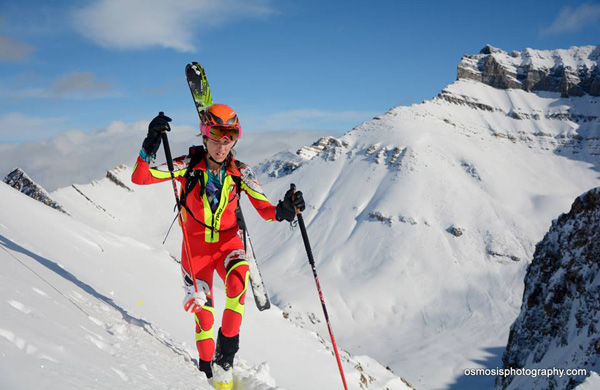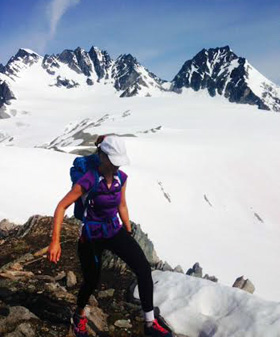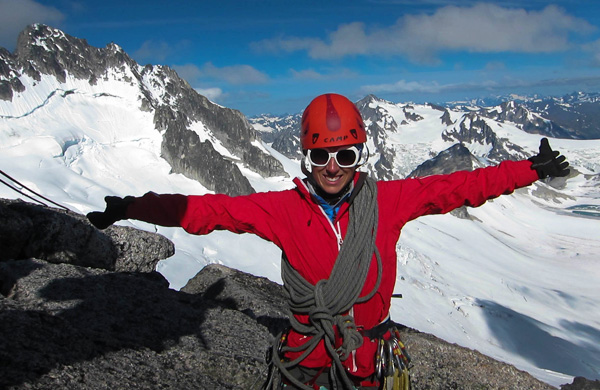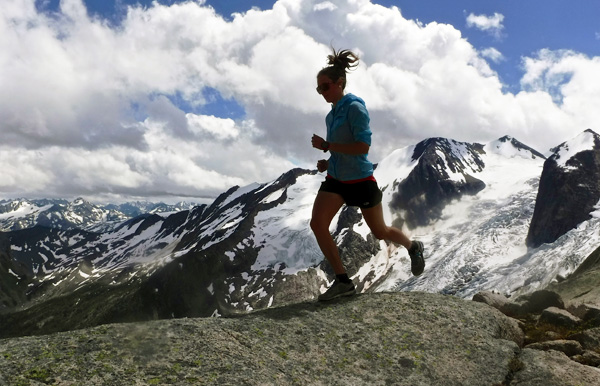Only few years ago, I remember Michelle crossing the finish line at Canadian Skimo Nationals a long time behind the fastest women and being somewhat terrified whenever a race course featured more technical descents. Since then she has made lots of progress. Her passion for our sport fueled her focus on learning and steadily improving to become one of the top Canadian women.

In this interview, we will find out about her road to skimo and how exactly she keeps improving every year.
Q: Michelle, which sports or activities were you participating in on regular basis before zooming in on skimo racing? And did you compete before skimo?
This is a question I get asked all the time. It’s quite interesting because I grew up hating phys ed class and what I learned from school was that I am not an athlete – I don’t belong in sports. From that, I can tell you that skimo was my introduction to competitive sports. I dabbled a bit in hiking, rock climbing and ice climbing. Once I finished university I bought a backcountry setup and a season pass at Sunshine Ski Village to learn how to ski. My first race was my third day on touring gear!
Q: What skills did you have to learn when coming to skimo and what aspects of the sport were the most intimidating?
Well, obviously I had to learn to ski, both uphill and down. As you know, the downhill component has been the most intimidating part of racing for me. It still continues to be an area that I need to improve upon, but each year I get a little better.
One big lesson I have learnt from skimo is knowing my body – listening and responding to it. I have learned how to pay attention to my heart rate and my muscles and have discovered not only how to pace myself but also how to push my limits beyond what I thought possible. It is so exciting for me to attempt new personal bests.
Q: Are you learning and progressing mostly on your own or do you have a coach or group of friends that help you out?
 My learning and progression has been a mixed bag of frustration and help from peers. I do not have a coach and before the SkinTrack’s Manual for Ski Mountaineering Racing I found it super hard to obtain any information on how to train for skimo.
My learning and progression has been a mixed bag of frustration and help from peers. I do not have a coach and before the SkinTrack’s Manual for Ski Mountaineering Racing I found it super hard to obtain any information on how to train for skimo.
I based my training models after cycling books. I feel lucky to have had you, Stano, as a support in watching me and giving me feedback. My teammate Travis has also given me tidbits of information during our training sessions.
But I would be lying if I didn’t disclose that I have had a lot of challenging days. Being at the back of the pack it is hard to observe skimo technique and race strategies when the only athletes are ahead of you and out of sight. I certainly learnt a lot through trial and error and failure.
Q: Now, as more a mature athlete, what do you find the most rewarding about our sport? What keeps you attracted?
Oh my gosh! I believe skimo is one of the most rewarding sports for too many reasons to state.
I imagine, just as athletes are attracted to triathlons, I too am fascinated with the multi-faceted components of gear, technique, cardio, endurance, and the outdoors. To be successful in skimo you have to excel in not only in downhill skiing, but also in fitness and mastery of your gear.
One other aspect that sets skimo apart from other endurance sports is the sacred experience of pushing your physical and mental boundaries in some of the most stunning landscapes. There’s a feeling of art as your skis carve lines on the mountain canvas, even if for only a moment in time.
Q: In recent years, you competed at World Skimo Championships. What was your experience like?
World Skimo Championships was a plethora of emotions. Given that it was my big goal, I had originally thought I would simply be satisfied to just “be” at world champs. However, once I arrived I wanted to do my absolute best and represent my country well. I wasn’t intimidated, but I was overwhelmed.
The competition is a massive step-up from North America and at times I felt like the underdog in Disney movies. My ending though didn’t come with a cheezy trophy finish. World Championships taught me a lot about racing and has given me new goals and new levels to grow towards.
Q: Let’s talk about training now. With summer in full swing, how does your training look like? Which sports or activities do you do? How much do you train? Do you race as well?
Recently, summer has been a challenge for me to get in quality training. I’ve been guiding backpacking trips, which gives me time outdoors with a backpack but the pace is often slow. I try to fit in mountain running and interval training whenever I can.
This summer I’ve registered for a few running races in the 50-60km range. I believe the races will help me to achieve new levels for endurance and hopefully help me maintain speed.
I also continue to love rock climbing. The focus has shifted a bit more towards mountaineering. I believe this is good cross training for skimo with the vertical miles as well as the endurance and mental training. If I can spend 10-15 hours on a rock with limited food and water I should be able to get through a 2-3 hour race.

Q: Then during winter are you able to get on skis for majority of your training or are you mixing in other sports?
In the winter, I focus mainly on skis and the strength training in the gym. On work days, the gym provides me the opportunity to build strength and power. I’m lucky enough to work in the mountains and can often get in a few ski days during the week as well as a good session with my team mates on the weekend.
Q: You are a vegetarian. What is your most favourite dinner meal during big training weeks? And what do you eat during long training sessions?
I love food! I enjoy eating many meals as long as they are fresh and full of spices and whole foods. As much as I love to eat, I view food as my fuel and look for food that is filled with nutrition.
My meals cycle and change with the season and my mood. Often I enjoy Chic pea curry with spinach or falafel loaded with greens and hummus. Lately, I am on a cold noodle bowl kick adding as many yummy vegetables to spring rolls and rice vermicelli. I do have a sweet tooth and I enjoy making a lot of yummy desserts as well.
Q: How do you balance work, training and life? How does your typical day look like?
Don’t know how to answer this question right now 🙂
I have to say that at times it is really hard. The past two years my employment has been erratic and not reliable. Sometimes I’ve worked 2 jobs and 12 hours a day totaling 60 hours/week, at other times I might have a 30 hour work week.
Q: Just like I asked Kylee Toth in her interview, I want to ask this wide ranging question: You have been involved in our sport as an athlete, ambassador and with the Canadian Skimo organization for a couple of years now. Based on your experience and point of view, what do you think can be done to attract more women into our sport? Why should they try it?
More women should try it because skimo is an incredibly empowering sport. Skimo cultivates abilities, confidence, and an improvement mentality that translates to all areas of life. I have formed some of the best friendships through skimo. I view my teammates and training partners as my second family. Once fall arrives I can’t wait to spend more time with my skimo “family.”
I think more support will attract women to the sport. It’s a big initial financial investment. I also perceive that women are intimated. I know I speak for Kylee as well that we would both like to see more mentorship opportunities.
Q: And one more question – If you could do a big backcountry ski trip, where would it be and why?
I would love to ski in South America one day. It seems so wild with its high peaks and big lines. Also the combination of culture and skiing appeals to me.

Footer
About SkinTrack
Travelling through snowy mountains on skis is like flying… and experiencing life at its core.
Gear reviews, interviews, adventures, contests, skills, skimo training, race reports – we connect you to all things related to self-propelled skiing.
SkinTrack.com, created by Stano Faban, was born out of passion for ski mountaineering and ski touring. Over the years, it has become one of the most popular ski mountaineering blogs in North America.
Recent Articles
- Kilian Jornet Interview: About His New Foundation, His Own Environmental Impact, and How He Wants To Help Athletes and The Outdoor Industry To Protect Nature
- How Fast Are Glaciers Really Melting? How Will This Affect Your Mountain Adventures? Interview with Pascal Egli
- Book Review – Art of Freedom: The Life and Climbs of Voytek Kurtyka
- Forest Skis: Innovative, Custom Build, For Backcountry Skiing and Freeride
- Lighter and Completely Redesigned: New CAMP Ultralight Ski Mountaineering Ice Axes
Useful Links
Comparing the lightest: Skis | Boots | Bindings
Skimo Training: Training Plans | Videos


Leave a Reply